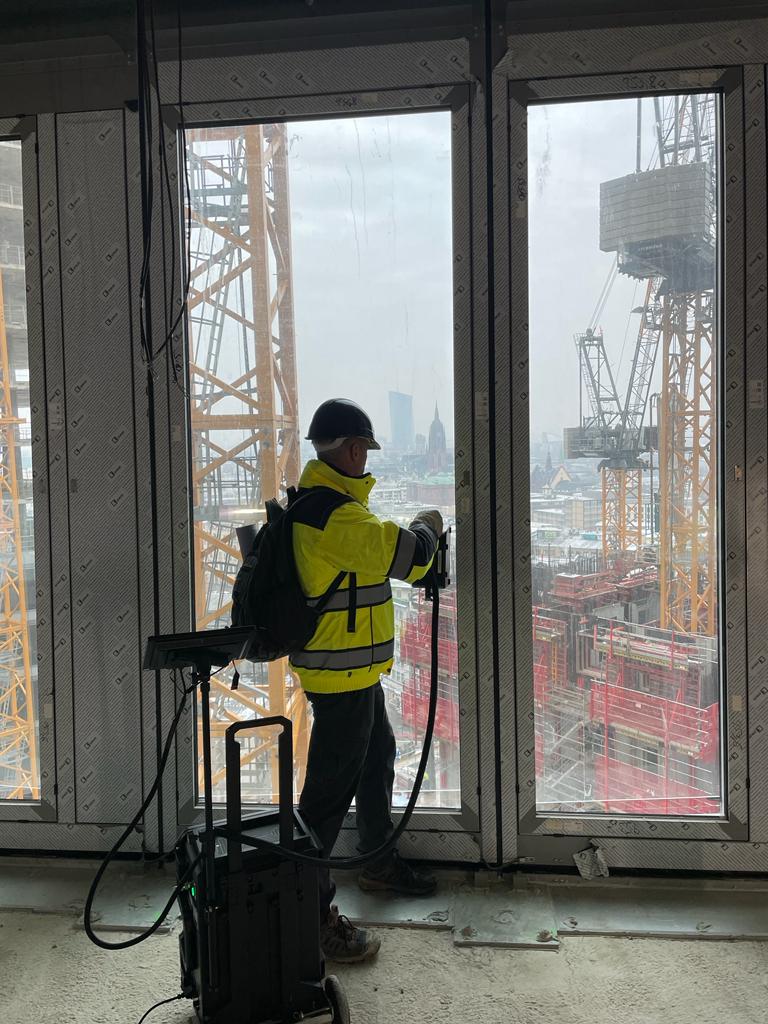Summary – Sustainable Glass Facades Depend on Gas Fill Quality: Long-Term Thermal Performance of Insulating Glass Units
- Insulating glass units (IGUs), or sealed units, are vital for achieving energy-efficient and sustainable building facades.
- Research from Glass Performance Days 2025 shows that gas fill quality directly determines an IGU’s long-term insulation performance.
- Even visually intact units can suffer gas loss over time, reducing thermal efficiency and increasing carbon emissions.
- Non-invasive gas measurement enables manufacturers and consultants to verify performance during production and throughout the building lifecycle.
- Reliable quality control through verified gas fill levels is essential to ensure durable, energy-efficient, and truly sustainable facades.
How long do insulating glass units (IGUs) also known as sealed units truly maintain their thermal performance? Recent research “Sustainable Glass Facades: Understanding the Long-Term Thermal Performance of IGUs” which was presented in Glass Performance Days 2025 reveals that an IGU’s performance is not static. Over time, gas leakage and coating deterioration can significantly reduce insulation efficiency, increasing both operational energy demand and a building’s carbon footprint.
For manufacturers, facade consultants, and architects, this raises a critical question:
How can we ensure that IGUs deliver reliable insulation over decades, not just at installation?
Watch Chris Davis and Kevin Yin’s presentation at GPD 2025 about their research:
How Gas Fill Quality Determines IGU Longevity
The study highlights that the argon or krypton gas fill rate directly determines whether an IGU will perform effectively throughout its lifespan:
| IGU Type | Argon Loss Rate | Resulting Performance Impact |
| Well-constructed units | <5% loss over 25 years | Negligible performance change |
| Units at EN 1279-3 leakage limit | ~1% loss per year | Reduced thermal efficiency but still compliant |
| Defective units | Up to 10% loss per year | Significant U-value increase, early failure risk |
Maintaining gas fill quality is therefore essential to achieving the long-term carbon savings and energy efficiency that sustainable facade design promises.
What Field Testing Reveals About Real-World IGU Performance
Field testing conducted in buildings up to 25 years old shows wide variation in argon concentration, even among identical IGUs. On average, many units fell below the 80% argon threshold defined in EN 1279-3.
Two key insights emerged:
- Visual inspection alone is insufficient. Many units that appear intact show degraded gas fill.
- Gas retention varies widely. Spacer type, seal quality, and installation precision all affect long-term performance.
These findings confirm that non-invasive testing methods, such as laser-based TDLAS gas analysis, are essential to verify the real insulation capacity of IGUs in both production and the field. Sparklike has been involved in field tests previously. Read here about how Sparklike Laser Portable was used at “On-site Insulating Glass Inspection for Gas In a Well-known Building“.

Non-Invasive Measurement: The Foundation of Sustainable Quality Control
For manufacturers and facade professionals, quality control is the foundation of sustainability.
With non-invasive gas measurement, you can:
- At production: Verify that every sealed unit leaves the factory within gas fill specifications.
- In the field: Evaluate existing facades and base renovation decisions on data, not assumptions.
- Across the lifecycle: Use real measurement data to feed into dynamic carbon models, ensuring that long-term performance aligns with net-zero strategies.
By measuring gas fill, rather than assuming it, manufacturers and consultants can ensure that every sealed unit continues to perform as designed throughout its service life.
Toward Net-Zero Through Verified Performance
IGUs are designed to last decades, but their true environmental value depends on consistent performance.
Testing gas fill levels offers a practical, immediate step toward:
- Extending the service life of sealed units
- Reducing operational and embodied carbon
- Supporting accurate carbon modeling across a building’s lifespan
Sustainable facades are not achieved by design alone they are maintained through reliable, measurable quality control.
More information on Sparklike’s solutions and their applications in IGU quality control.
Source:
Davis, C., Granvik, T., Yin, K., Sellman, R., Back, R., Scherer, C., & Giovanni, L. (2025). Sustainable Glass Facades: Understanding the Long-Term Thermal Performance of IGUs. In J. Belis, C. Louter, & M. Mökkönen (Eds.), Glass Performance Conference Proceedings, Volume 1. Glass Performance Days. Read the full paper

